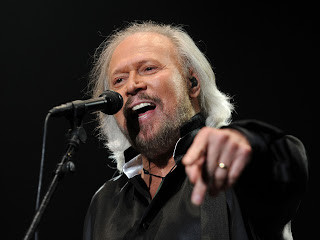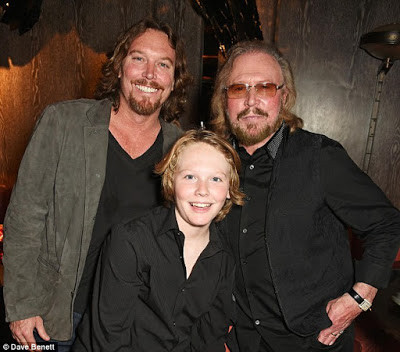Forty years after it topped the US charts, the infectious energy of “You Should Be Dancing” by the Bee Gees still compels listeners to move. This disco classic, released in 1976, wasn’t just another hit song; it was a meticulously crafted piece of music born from experimentation and a desire to make people dance. In this deep dive, we explore the fascinating backstory of “You Should Be Dancing” through excerpts from a revealing interview with Barry Gibb, offering a glimpse into the song’s creation and enduring appeal. Get ready to rediscover why these are Lyrics You Should Be Dancing to.
Barry Gibb himself recently witnessed the power of dance firsthand, as he recounted in the interview. Describing a scene from a Sony Summer Party in London, Gibb shared an endearing anecdote about his grandson Lucas: “And that was at the Sony Summer Party and can Lucas dance! We’d never seen this before (laughs), but he was all over the floor, you know? But the rest of us could only look on in amazement. This kid’s got some fantastic moves.” This intergenerational appreciation for dance, sparked by music, mirrors the timeless quality of “You Should Be Dancing,” a song that continues to inspire movement across generations.
The Birth of a Disco Classic: Crafting “You Should Be Dancing”
The interviewer, Tim Roxborogh, skillfully connected this personal anecdote to the song’s 40th anniversary, prompting Gibb to delve into the memories of creating this iconic track. Roxborogh remarked, “That brings me then to the 40th anniversary of You Should Be Dancing going to US number one [in early September 1976], it was just the other day.” He further hinted at the song’s intricate production, “If we briefly go back, because that song’s got some cool stories like Stephen Stills on percussion and something like 16 layers of percussion, are there any sort of fun things you can remember about recording that song?”
Gibb’s response revealed the dedication and meticulous effort poured into the song: “Oh I remember a lot of that song. I remember that we cut the track at least four times. That we fixed things over and over again throughout that two weeks that it took to put that altogether.” This iterative process highlights the Bee Gees’ commitment to perfection, pushing themselves to refine the track until it reached its full potential. The mention of Stephen Stills, a rock legend, contributing percussion at “5 in the morning” adds to the song’s intriguing backstory, showcasing the collaborative and experimental atmosphere of the recording sessions. Gibb elaborated, “And Stephen Stills playing percussion at 5 in the morning, you know? With um, playing sticks. And just the incredible environment that we were discovering something. We were discovering more accurate rhythms, we were discovering Latin rhythms and because we lived in Miami that was all around us so it just happened that way, you know? But it’s still very vivid.” The Miami influence, with its vibrant Latin rhythms, organically seeped into their music, contributing to the unique sound of “You Should Be Dancing.”
Unlayering the Sonic Details: Barry Gibb’s Falsetto Secret
Roxborogh, a keen listener, pointed out a fascinating detail often missed in the final mix: “It’s one of those ones I love to listen to loud and just try and hear all the different detail in it. I only discovered recently that you’re doing falsetto singing along with the trumpet solo. And I only found that out because on YouTube you can listen to just the vocal with none of the instrumentation.” This observation unveils a hidden layer of Gibb’s vocal artistry within the instrumental break, a testament to their innovative studio techniques.
Gibb confirmed this and explained their experimental approach to sound design: “Yeah. I think we did things like that. I did the explosion on Tragedy and things like that, just by mouth and Karl Richardson would add various things to that to create that explosion. With You Should Be Dancing it was the sudden emergence of having as many tracks as you wanted. So you would always add something else that made it unusual.” This “more is more” philosophy, enabled by evolving recording technology, allowed them to enrich their tracks with unexpected sonic textures, like Gibb’s vocal doubling the trumpet solo. He further revealed his vocal contributions to other instrumental parts, “I’m singing the instrumental in Jive Talkin’, you know? Because if everything sticks together it becomes a little bit more unusual. But you kept trying things, you just kept trying things. Some things stuck and some things didn’t…”
The Art of the Mix: A Collaborative Balancing Act
Mixing “You Should Be Dancing” was not a simple task, Gibb recalled, emphasizing the limitations of the analog technology of the time: “…but I remember that You Should Be Dancing in particular, it took 10 of us to mix that song. [As in], 10 at the board. You couldn’t update anything, there was no such thing. So you had to do the whole mix at once with everybody moving faders. My fader was the repeat of the echo of (breaking into falsetto) “Whatcha’ doin’ on ya’ back?” There’s a little repeat on that…” This description paints a vivid picture of a collaborative, real-time mixing process, a far cry from today’s digital workstations with unlimited undo options. Every element, every echo, had to be precisely executed in a single take, highlighting the pressure and skill involved. Gibb humorously added, “That’s my job! (laughs)… But if somebody got something wrong, you had to do the whole thing again. In those days you couldn’t keep anything. There was no computerized scenario, you know?”
A Feeling of Something Special: From Studio to Smash Hit
Despite the challenges, there was an undeniable feeling during the creation of “You Should Be Dancing” that they were onto something special. When Roxborogh asked if they knew it would be a hit, Gibb responded with a nuanced perspective: “Well I don’t think you can ever say that about any song. I think you can look at each other and go, “this is great. This is special.” Whether it’s chart special or radio special, this was special for us.” While chart success is never guaranteed, the Bee Gees recognized the unique energy and appeal of “You Should Be Dancing” as they crafted it.
Gibb further elaborated on their inspiration, connecting it to the burgeoning dance scene: “…we were just having a great time with You Should Be Dancing because suddenly everyone was wanting to dance and we wanted to make a record like that. So I think it was us doing that.” The song was a deliberate creation to meet the growing demand for dance music, reflecting the cultural shift towards disco. Drawing parallels to musical admiration, Gibb concluded, “There’s someone out there you really admire and you want to do a song like that so You Should Be Dancing fits that mold.”
“You Should Be Dancing” stands as a testament to the Bee Gees’ musical innovation, studio craftsmanship, and keen sense of cultural trends. More than just catchy lyrics you should be dancing to, it’s a meticulously constructed soundscape, full of hidden details and collaborative artistry, that continues to resonate and inspire movement four decades later.


